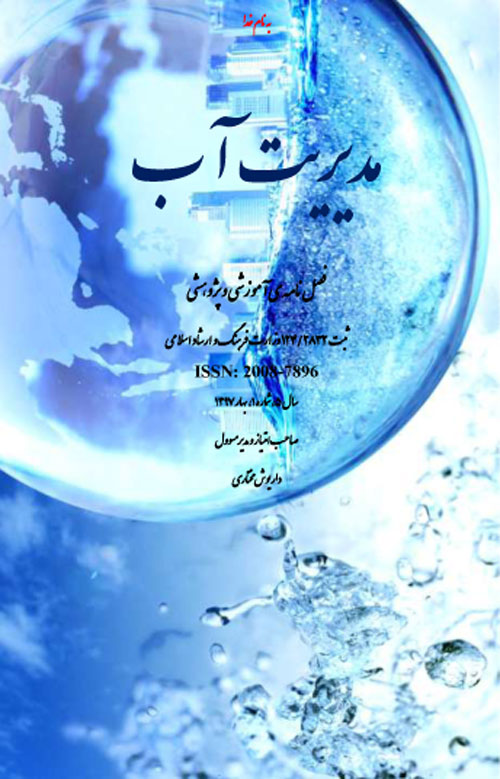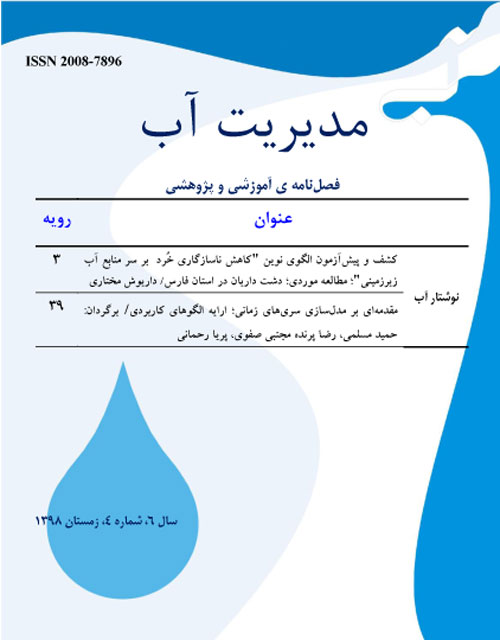فهرست مطالب

نشریه مدیریت آب
سال پنجم شماره 1 (پیاپی 12، بهار 1397)
- تاریخ انتشار: 1397/03/08
- تعداد عناوین: 3
- گام های اجرایی نو (نرم افزاری) در مدیریت آب
-
صفحات 3-31
در این نوشته، نمونه های کوچکی ارایه شده است که چگونه می توان از نوشته های تاریخی معتبر و مستند برای اطلاع از شرایط دمایی و هواشناسی کمک گرفت. هر جایی اطلاعاتی از یخبندان، سرما، دما، بارش (برف یا باران) با یاد تاریخ و روز آن درج شده باشد می تواند اطلاعاتی پیرامون هواشناسی باشد. گرچه همانند هواشناسی امروزین مشخصات دمایی یا بارش را نمی توان به صورت کمی استخراج کرد، بلکه تنها می توان به صورت کیفی از اطلاعات استفاده کرد. به این سان، می توان نام این کنکاش را شاخه ای از دانش هواشناسی نامید؛ "هواشناسی تاریخی". از یافته های این دانش می توان برای بازشناسی دوره های قحطی، بازشناسی چگونگی به تعادل رسیدن دوباره آبخوان ها و دریاچه ها و غیره کمک گرفت. نگاه این گرایش از دانش هواشناسی، حل مساله خشکسالی است.
کلیدواژگان: هواشناسی، تاریخ، زیست بوم، شیراز - نوشتار آب
-
صفحات 35-46
هدف این نوشتار، امکان سنجی استفاده از تصاویر ماهواره ای در تشخیص پدیده یوتروفی شدن در اراضی حاشیه دریاچه مهارلو است. به این منظور تصاویر رقومی سنجنده +ETM ماهواره لندست 7 و انواع پردازش های رقومی اعمال شده از جمله تصحیحات ژئومتری و رادیومتری و همچنین بهبود کنتراست تصاویر استفاده شد و پس از پردازش های نهایی، نقشه ی پهنه بندی مناطق یوتروفی شده تهیه شد. نتایج نشان داد که نقاط بحرانی یوتروفی شده حاشیه دریاچه مهارلو رخ داده است. بنابراین شایسته است از ورود آلاینده ها و پساب شهر شیراز به این دریاچه جلوگیری به عمل آید.
کلیدواژگان: یوتروفی شدن، آلودگی آب، RS، GIS، دریاچه مهارلو، شیراز -
صفحات 47-64
در وضعیت کنونی، نهاده آب به عنوان یک نهاده با ارزش میباشد که باید به استفاده بهینه آن پرداخت. دشت فیروزآباد در سالهای اخیر به دلیل بهرهبرداری بیرویه از منابع آب زیرزمینی با افت شدید سطح ایستایی و افزایش سریع شوری آب و پیامدهای منفی آن در توسعه کشاورزی روبرو شده است. در این مطالعه دو هدف ناهمسو، افزایش منافع اقتصادی و کاهش اثرات منفی زیست محیطی، همراه با 13سناریوی مختلف برداشت از منابع آب زیرزمینی مورد بررسی قرار گرفته است. به منظور تعیین الگوی کشت بهینه و درآمد خالص در شرایط استفاده تلفیقی از منابع آب سطحی و زیرزمینی از مدل برنامه ریزی خطی و نیز برای محاسبه اثرات زیست محیطی از ضریب برداشت بیش از حد استفاده شده است. نتایج حاکی از آن است که کاهش برداشت از منابع آب و اجرای الگوی کشت مناسب، موجبات توسعه پایدار در بخش کشاورزی را امکان پذیرتر می کند.
کلیدواژگان: منابع آب سطحی و زیرزمینی، اثرات زیست محیطی، توسعه پایدار، دشت فیروزآباد
-
Pages 3-31
This article provides small examples of how to use reliable and documented historical literature to help understand temperature and meteorological conditions. Anywhere information on frost, cold, temperature, precipitation (snow or rain) with date and day is included can be meteorological information. However, as with today's meteorological, the temperature or precipitation characteristics cannot be quantitatively extracted, Only qualitative information can be used. Thus, one can call this discovery a branch of meteorological knowledge, "historical meteorology". Findings from this knowledge can help to identify periods of famine, how to balance aquifers and lakes, and so on. Looking at this branch of meteorological knowledge is the solution to the drought problem.
Keywords: Meteorology, History, Ecosystem, Shiraz -
Pages 35-46
The purpose of this article is to investigate the feasibility of using satellite images to detect eutrophication phenomena in the marginal lands of Maharlo Lake. For this purpose, Landsat 7 satellite ETM + digital images and a variety of digital processing were applied, including geometric and radiometric corrections as well as image contrast enhancement. The results showed that eutrophication critical points of Maharlo Lake margin occurred. Therefore, it is appropriate to prevent contaminants and wastewater from entering Shiraz.
Keywords: Eutrophication, Water pollution, GIS, RS, Maharlo Lake, Shiraz -
Pages 47-64
In the current situation, water input is a valuable input that needs to be optimized. Firouzabad Plain has been encountered with the sharp decline in the groundwater level and the rapid increase in water salinity and their associated complications in agricultural development, due to immethodical exploitation of groundwater resources, in recent years. In this study, two conflicting objectives include to "increasing economic benefits" and "reducing negative environmental impacts", along with 13 different scenarios for harvesting of groundwater resources have been investigated. In order to determine the optimum cropping pattern and net income in terms of combined use of surface water and groundwater sources, a linear programming model as well as for calculating the environmental impacts of over harvesting coefficient have been used. The results indicate that reducing withdrawal of water resources and implementing a suitable cropping pattern will make sustainable development in the agricultural sector more possible.
Keywords: Surface, Groundwater Resources, Environmental Impacts, Sustainable Development, Firouzabad Plain


